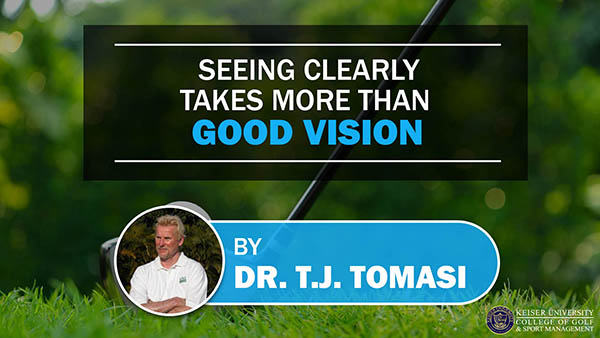Seeing Clearly Takes More Than Good Vision

By Dr. T. J. Tomasi, Keiser University College of Golf Senior Faculty and Director of Research
“The eye altering, alters all.” — William Blake
Most people believe that what they see is an accurate representation of what is actually there. But science shows us that our vision is a composite — part objective and part subjective. And, while the objective, physical apparatuses (eyes, retina, optic nerve, etc.) we see with are the same for nearly everybody, the interpretive aspect of vision, i.e., what the physical image means to us — can be very different from person to person, group to group and culture to culture.
I remember playing a round of golf with a very good player, who that day complained about the pin placements, and she played way below her ability. She saw her performance as the fault of the pin locations, but that wasn’t the cause because the pins were not penal that day; instead, her perception of her own efficacy caused her to see tough pins.
To make the point, I offer the strange case of a blind 30-something female who was clinically evaluated to have multiple personalities (10 in all). Brain scans showed no physical damage to her mechanical seeing system, but her doctors concluded that emotional trauma set the stage for her psychological blindness. During treatment, eight of her personalities regained sight while two remained blind. It was pretty unusual because seconds after a blind personality took center stage from a sighted personality, she went from clear sight to darkness.
One of her doctors, Hans Strasburger of Ludwig Maximilian University in Munich, Germany, said: “In situations that are emotionally intense, the patient occasionally feels the wish to become blind.” Research shows that in some cases, the trauma precedes the onset of symptoms by up to 15 years.
A more common occurrence of this strategic blindness happens when a golfer misses a critical putt. He’ll go from wide-eyed focus to eyes shut tight, a temporary blindness designed to shut out the traumatic scene. It’s a reflex mechanism —- like ducking.
On the pro tour, it’s the role of caddies to help “see” the target as it really is, a role that makes them an integral part of the player’s team. But if you’re like most golfers, you don’t have a caddy, so you must practice creating realistic images of the target scene using your pre-shot routine.
An integral part of that routine is a measurement of the shot’s parameters — how far is the pin, where are the hazards, what’s the wind doing, what score do I need, and what score can’t I survive? “Digitizing” the target scene helps ensure that the objective part of your seeing system is as accurate as it can be.
If you’d like to study with Dr. Tomasi and other PGA Master Professionals, contact The College of Golf today.












